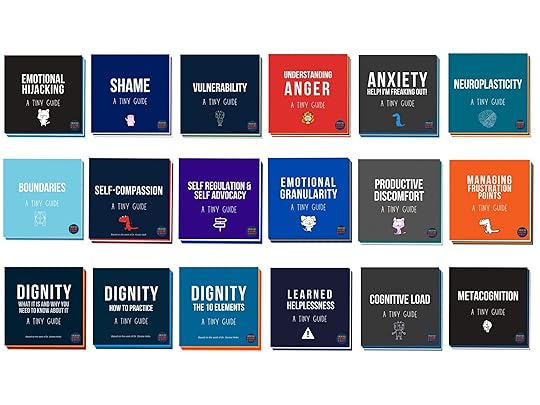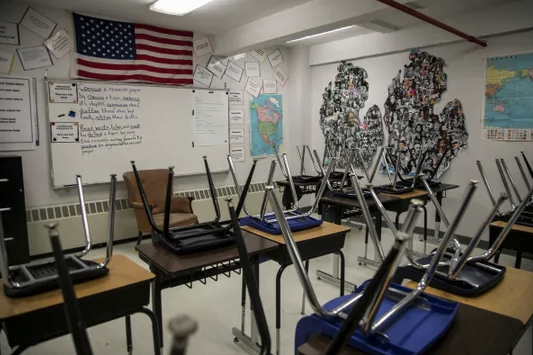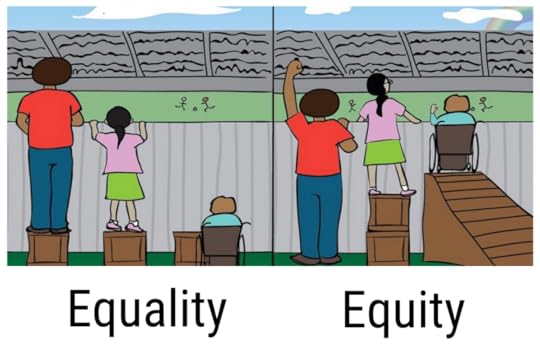Rosalind Wiseman's Blog, page 10
May 22, 2020
Webinar: Managing emotions in hard times
We can all get overwhelmed by our emotions, especially during these challenging times. We need tools to manage ourselves and our relationships with our children. Navigating our lives during a pandemic is a first for all of us and no one is born knowing how to parent during quarantine.
Cultures of Dignity’s Megan Saxelby and PEN’s Shelly Mahon discuss dealing with difficult emotions.
During this webinar you will:
Be guided through a Tiny Guide on emotional hijacking that helps you understand why we can get overwhelmed while also giving you concrete strategies to gain control
Get tools and resources to better manage conflict within your household.
Explore Tiny Guides
Recent Posts
Webinar: Managing emotions in hard times
Prioritizing Art During a Global Pandemic
A Conversation Between Siblings Stuck in Quarantine
The post Webinar: Managing emotions in hard times appeared first on Cultures of Dignity.
May 12, 2020
Prioritizing Art During a Global Pandemic
Sara is a high school junior from Longmont, CO and an intern with Cultures of Dignity. Below are her thoughts on the importance of art during quarantine.
Prioritizing Art During a Global Pandemic
By Sara Davis
Art has always been our way of coping and understanding the pain, sorrow, and joy that life brings. Art is uniquely human experience. It’s what separates us from the other animals we share our planet with. And now, in a time where the daily routines of millions of people have been turned on their head and we are eager to be distracted from an unfamiliar world, art is again where we seek refuge from the chaos.
The most important thing that an artist can do is to captivate their audience’s attention. Today, art may not come in the form we hoped, since many theaters, museums, concert halls, and exhibits had to be either canceled, postponed, or shut down. But since we live in a brilliant age of technology, we’ve found a few solutions. Musicians are performing concerts from their homes, and stand up comedians are using social media to make sure their followers don’t forget to laugh a little in the midst of everything they have to face. You can stream your favorite classical music from the Berlin Orchestra, or discover stunning shows from the Metropolitan Opera. If you’ve seen the Tony awards and you’re wondering what the fuss is all about, watch one new Broadway musical a week on Youtube.
For me and my peers, art has become a source of comfort. My friends and I have done everything from painting, to embroidery, to singing and playing instruments, to making jewelry boxes and flower crowns, and having dance parties alone in our rooms. Even though my high school play got canceled, I still learned all of my lines, and I’ve been making bracelets for my family. I know people who have shaved their heads, learned very elaborate TikTok dances, or pierced their ears and given themselves stick and poke tattoos. All of these actions seem like nothing more than the crazy, rash decisions of teenagers during a pandemic.

TikTok dances with family
But art is important, never more so in a time like this when a person’s mental health is in danger. As Cultures of Dignity works so hard to demonstrate, the actions of young people are often more than meets the eye. People finally have the freedom to use art and creativity to do all of the things they’ve ever thought about doing. Whether you’ve always wanted to learn to bake like the people on Pinterest, or just made a spur of the moment decision to turn all of your old jeans into shorts, the social pressure is gone. There is no need to worry about judgement from the people around you. Because in quarantine, you can keep all of that to yourself if you want to.
It took being cooped up at home for people to really feel like they were free. That seems like a contradictory idea, I know. But when people have the time to make or experience art, they have the time to truly be themselves. When you are in a safe space, it doesn’t matter if you fail. You can try something over and over and over. You can leave a project alone for a while, and come back to it later. So what if your knitting experiment didn’t work out? Why not get bangs? Or watch that movie on Netflix that seems a little strange? Or buy a painting from a local artist on Instagram? Who cares if you picked up an old instrument and sounded terrible? You are perfectly free to try anything you want. Nobody but you has to know. Creative expression is no longer just what everyone around you wants to see, but however you want to present yourself.
It took being cooped up at home for people to really feel like they were free.
The most beautiful thing about staying at home, is that failure, trial and error are no longer anything to be feared. People right now are taking an opportunity to reacquaint themselves with creative passions they may have lost in the day to day course of their lives before the coronavirus pandemic. Nobody has to worry about being judged for dancing alone, trying to bake a seven layer cake, or reading a silly book. There’s no need to hide away your knitting supplies, or the draft of that story you’ve been wanting to write. Give yourself the experience of seeing and creating as much art as you possibly can, because art creates hope and the ability to keep going.
Art, as we now see, is fundamental to the human condition. We need it not only to feel like ourselves, but also to preserve our own mental health and sanity. Art as a priority can get lost during the normal hustle and bustle of life. Hopefully during this time, everyone gets a chance to feel what forms of art mean the most to them. To be yourself, all you need is art and a little bit of time.
If you have any questions or comments for Sara, reach out to curious@culturesofdignity.com
Recent Posts
Prioritizing Art During a Global Pandemic
A Conversation Between Siblings Stuck in Quarantine
Meet Our Newest Editorial Advisors!
The post Prioritizing Art During a Global Pandemic appeared first on Cultures of Dignity.
May 8, 2020
A Conversation Between Siblings Stuck in Quarantine
Charlie Daly is a sophomore at Boulder High School and an intern at Cultures of Dignity. He sat down with his sister, a freshman at Boston University to talk about what it’s been like to be siblings in quarantine, dealing with the boredom, getting super attached to TV shows, and surviving family problems. Listen below.
A Conversation Between Siblings Stuck in Quarantine
Prior to this quarantine, my family has been spread out across the country while I lived home in Boulder with our parents. My brother lives in Portland and my two sisters are attending college on the East Coast.
When Coronavirus lockdowns began, my sister just happened to be back home from Boston University on spring break and now she’s stuck here. This reintroduction of my sister into the family dynamic was an adjustment, especially since we happened to be staying in an apartment as our house gets renovated.
Listen to my sister Georgia and I discuss surviving the boredom, dealing with our parents, becoming friends, and conflict during quarantine.
https://culturesofdignity.com/wp-content/uploads/2020/05/Project-5_3_20-12.47-PM.mp3
If you have any questions or comments for Charlie and his sister, reach out to curious@culturesofdignity.com
Recent Posts
A Conversation Between Siblings Stuck in Quarantine
Meet Our Newest Editorial Advisors!
Having anxiety meltdowns and temper tantrums in front of your kids during covid-19? Here’s some advice on what to do next.
The post A Conversation Between Siblings Stuck in Quarantine appeared first on Cultures of Dignity.
May 4, 2020
Meet Our Newest Editorial Advisors!
The Cultures of Dignity Editorial Advisors review and provide feedback on all of our work. We rely on young people let us know when we are wrong on all of the content we send into the world – from lesson plans, to blogs, to presentations.
Young people are experts on what it means to live in this day and age but don’t always get to share their voice. At Cultures of Dignity, we get to listen to young people.
Get to know our newest editorial advisors below!
Recent Posts
Meet Our Newest Editorial Advisors!
Having anxiety meltdowns and temper tantrums in front of your kids during covid-19? Here’s some advice on what to do next.
PODCAST: Discussing difficult topics around 2020 Election and COVID-19 with Rosalind Wiseman, Megan Saxelby and Jen Cort

Lara is a 16 year old junior from Boulder, Colorado. In her free time she enjoys exploring the trails with her dog.

Trinidad is a Junior at Frankfurt International School, loves Korean pop, and is passionate about learning animals and medicine.

Gabriella is a high school junior from Southwestern PA, who loves dogs and is passionate about spreading kindness!

Emily Bach is a writer and creator with a passion for women’s issues and immigration reform. In her free time, Emily enjoys exploring Washington, DC, the city she loves and lives in.

Benjamin is in 8th grade at Rogers Middle School in Long Beach, California. He is a sport fanatic and loves playing baseball. He is a Boy Scout working toward his Eagle and also enjoys golf and playing the sax. He is interested in helping young people understand the impact of social media on their lives.

Julie is currently attending high school at an international school, she would like to go into law and she is seriously addicted to Ben&Jerry’s .

Lauren is a senior at Allderdice High School who loves to travel with friends, and make the world a better place using her program Keeping Up With Kindness.

Ava Heppner will be a Freshman at SMU next year, loves dogs, and is passionate about improving safety in schools along with gun control.

Gus is a 9th grader from northern New Jersey. In his free time he enjoys playing basketball and spending time with friends.

Shubhangi is in 10th grade at Paloma Valley High School in CA and is passionate about making her community a better place.
We accept applicants for the Editorial Advisors on a rolling basis.
Feel free to apply at any time or pass this along to a young person who would be interested!
APPLY
The post Meet Our Newest Editorial Advisors! appeared first on Cultures of Dignity.
April 30, 2020
Having anxiety meltdowns and temper tantrums in front of your kids during covid-19? Here’s some advice on what to do next.
Having anxiety meltdowns and temper tantrums in front of your kids during covid-19? Here’s some advice on what to do next.
By Rosalind Wiseman
Maybe we started off “sheltering in place” by listening to podcasts and welcoming the “opportunity” to bake bread or watch too much TikTok and Netflix. Now, we’re understandably challenged to maintain our equilibrium. And sometimes that can come out as grown-up temper tantrums and anxiety meltdowns as anxiety, frustration or anger get the best of us.
No parent can manage their lives perfectly. It wasn’t possible before covid-19 — despite our curated social media posts to the contrary — and it’s not possible now. Trying to be the perfect parent has always distracted us from being the parents our children need us to be: people who can acknowledge our struggles and mistakes with messy grace.
We’re all struggling together.
I never have one second to myself and everyone in my family hates me … the bar for my sanity is very low. — Karen, mother of 4.
I never used to swear at my kids. Never. Now I start every day by walking into my kitchen and screaming obscenities because they always leave it a huge mess. — Annabelle, mother of 3.
We will all have bad moments; it’s how we get through them that matters.
After the anxiety meltdowns:
It can be unnerving for our children to see us really upset or anxious, but we can reassure them by talking about it in a straightforward, compassionate way. For younger children, we can comfort them by saying:
“I’m sorry it was hard for you to see me upset. I feel better now that I [fill in the blank: took a minute, took a breath, exercised, etc.]. Why don’t you pick out a book (or some calming activity) we can do together?”
For teens, you can modify with:
“I’m feeling overwhelmed because of [state general reason]. We’re all figuring it out together. I’m going to take a few minutes to calm myself down, and we can talk about it if you want. Even though I was upset, I can still support you too if you’re struggling.”
After the grown-up temper tantrums:
For various reasons, most of us struggle to express our anger in healthy ways; a grown-up temper tantrum is directly connected to the way we were taught to express — or repress — our feelings.
Just as we experienced with our parents, our children witness or even are on the receiving end of our anger. In the situation we’re in right now, the small acts of living together can bring up all of our anger baggage into some messy moments. And no matter how we express our anger, the following is usually true:
We love our children and they can be incredibly annoying.
We’re equally annoying to our children. Our children think our “helpful” reminders are unnecessary and irritating.
Most of our children are bad roommates; like when they take your computer charger and don’t return it, or when they leave food out and the dog eats it (and the bag it came in). And somehow, they never see the dog vomit on the carpet until you point it out.
Our concept of time is different. When we tell our children to clean the kitchen, we mean now. In their minds, time is more fluid. They have every intention of cleaning up … sometime in the future.
No one pushes our buttons quite like the people in our family.
Imagine you’ve just yelled at your kids because they had a loud, obnoxious argument that interrupted a work call. You’ve now locked yourself in your bedroom, furious. How do you walk out of that room and reengage with your family? Pretend nothing happened? Give them death stares? Apologize for losing your temper but be resentful for the understandable reasons you got angry in the first place?
All of those are options, but they tend to bury the conflict until the next blowup.
Or, we can remember that even though we really don’t feel like it sometimes, our sacred responsibility to our children is to be good role-models and provide an emotionally stable home.
Taking responsibility for how you express anger does both. So, keep these things in mind if you’re going to talk to the person who was on the receiving end of your temper tantrum:
While the way you expressed your anger may not have been the most mature way to show your feelings, you have a right to be upset.
Don’t repeat yourself or come to the conversation with a long list of grievances to justify your feelings. You don’t need 27 reasons; you only need one. (Repeatedly, teens have told me that when their parents do that, they feel overwhelmed and shut down. Your rational argument comes across as a rant.)
If you don’t feel like you’re being listened to, stop speaking, take a breath and then say, “I’m getting angry again because I don’t think you’re listening to me. I’m going to take a break from this conversation, and we’ll talk about it later this evening.” Then do what you say: Walk away.
Your dignity, and everyone else’s, is nonnegotiable.
Making amends
Apologizing for the temper tantrum shows your children how adults take responsibility for their actions. You’re not apologizing for your feelings; you’re apologizing for the way you handled it. Just be prepared to back up your words with deeds. The next time you’re angry, there has to be at least a small improvement in how you express yourself. Otherwise, you lose any credibility you gained.
Living with fierce grace
No matter what’s going on in the world, we’re all messy. Our relationships are messy. We need to laugh when possible, give ourselves and the people we love a break, and live with fierce grace as we manage ourselves under exceptional circumstances.
Our children must see us admit our mistakes, hold ourselves (and them) accountable when necessary, and strive to manage ourselves with dignity. The moment we do that, our children feel safe, loved and assured that the adult who cares for them can comfort them through difficult times.
For more strategies and tools for managing yourself and your relationships, check out Tiny Guides!
 Tiny Guides help you quickly comprehend core social and emotional concepts, understand their impact on your relationships, and equip you with tools to put them into action.
Tiny Guides help you quickly comprehend core social and emotional concepts, understand their impact on your relationships, and equip you with tools to put them into action.
Recent Posts
Having anxiety meltdowns and temper tantrums in front of your kids during covid-19? Here’s some advice on what to do next.
PODCAST: Discussing difficult topics around 2020 Election and COVID-19 with Rosalind Wiseman, Megan Saxelby and Jen Cort
Surviving My Relationship During A Global Pandemic
The post Having anxiety meltdowns and temper tantrums in front of your kids during covid-19? Here’s some advice on what to do next. appeared first on Cultures of Dignity.
April 28, 2020
PODCAST: Discussing difficult topics around 2020 Election and COVID-19 with Rosalind Wiseman, Megan Saxelby and Jen Cort
Creating space for young people to share opinions and disagree with each other is the foundation for educating future generations of engaged citizens who are capable of civil discourse. Unfortunately, many schools have struggled to create this space; often we are understandably reluctant to allow this kind of learning environment for fear of becoming entangled in controversy and conflict. The irony is that our reluctance feeds the cycle; when adults are unable or unwilling to provide the education required for civil debate, young people will be unprepared to develop into adults with the necessary skills to improve our political discourse.
But it doesn’t have to be this way.
We can create educational spaces that are appropriately uncomfortable; because that is how we consider new ideas, reflect on our own (even strongly held) positions, and build skills to become informed, critical thinkers.
Cultures of Dignity’s Rosalind Wiseman and Megan Saxelby joined Jen Cort on Third Space Podcast to discuss how to do this by first creating the foundation of dignity to then engage in tough conversations.
Give it a listen and let us know what you think!
Listen to "Discussing difficult topics around the 2020 election and COVID-19 ft. Rosalind Wiseman and Megan Saxelby" on Spreaker.
This is a part of our Navigating Politics with Dignity in the New Decade Initiative!
More Resources & Materials
Podcast Notes
Rosalind, a returning guest is the founder of Cultures of Dignity, a contributor and curriculum creator for the Anti-Defamation League and as a multiple New York Times Bestseller best known for being the author of Queen Bees and Wannabes: the groundbreaking, best-selling book that was the basis for the movie and Broadway Musical Mean Girls, and was fully revised for a third edition. Wiseman is the author of the Owning Up Curriculum, a comprehensive social justice program for grades 4-12 which is in widespread use across the world. She has been profiled in or written for The New York Times, TIME, and the Washington Post among others and is a frequent guest on the Today Show, CNN, Good Morning America, and National Public Radio. She lives in Boulder Colorado with her husband and two sons. rosalind@culturesofdignity.com
Megan was a middle and high school educator for 12 years and is an expert in dignity and social-emotional learning. Her work combines research in neuroscience, conflict resolution, social responsibility, and critical thinking to create transformative approaches that develop the whole person. Megan specializes in creating programming that prioritizes the development of emotional intelligence and creates cultures of dignity. megan@culturesofdignity.com
Link to the tiny guides:
https://store.culturesofdignity.com/
Recent Posts
PODCAST: Discussing difficult topics around 2020 Election and COVID-19 with Rosalind Wiseman, Megan Saxelby and Jen Cort
Surviving My Relationship During A Global Pandemic
You Hate Each Other… Now What?
The post PODCAST: Discussing difficult topics around 2020 Election and COVID-19 with Rosalind Wiseman, Megan Saxelby and Jen Cort appeared first on Cultures of Dignity.
April 15, 2020
Surviving My Relationship During A Global Pandemic
Gabriella is a high school senior in Pennsylvania and serves on the Cultures of Dignity Advisory Board. Below are her thoughts on the challenge of navigating a relationship during a COVID-19.
Surviving My Relationship During A Global Pandemic
By Gabriella Spina
I hadn’t seen my boyfriend for a whole week. I know, big whoop. It was Saturday, a few days before our governor demanded the close of all non-essential businesses, and we had made some loose plans to get together. I was excited, I always am to see him, but I was specifically looking forward to that night because I had a great day, and selfishly, I wanted to see him to make my great day a perfect one. As six became seven, then eight, and then finally nine, and I raced to check my phone at every ping and ding, and I still had not heard from him. I decided that I had to get on with my night. He texted me a little bit later saying that he had fallen asleep with a headache. He wanted to see me tomorrow, but I was furious. We are high school seniors and with the Coronavirus already reducing our contact, our tomorrows are limited, and he knew that.
I saw him on Sunday. He sat on one concrete stair and I sat a few below, different from our usual shoulder to shoulder conversations but necessary to protect his grandparents that were staying with his family. We both understood that I was upset, but in that moment, I refused to address my feelings because I didn’t want to be upset when I only had a few moments to spend with him.
While texting over the past few days, we shared a few moments that we deemed “tabled,” or anecdotes that we wanted to share in person, but sitting below him, I could not recall one. Our conversation was choppy and unnatural, and I was slightly passive aggressive. It wasn’t the interaction I wanted for us, nor what I imagined. As excited as I was to see him and as limited as our time was, I left early because I wanted our moment to be sweet and exciting, not painfully forced. In retrospect, I acted unfairly. I hadn’t explained why I was angry; instead choosing to keep my tension and frustration in myself.

Mandi Wright, Detroit Free Press
So to all my fellow socially-distanced ones love birds out there, your significant other may be experiencing isolation differently, and they may have other tribulations going on in their lives. Your relationship was never supposed to endure a global pandemic, but the beautiful part is that it can.
The shift from seeing my partner every morning at 7:40 in history class to once-a-week if I am lucky, os uncomfortable to say the least. We had essentially built a routine, and I always knew when the next time I would see him was. In an attempt to normalize our relationship and seek comfort in an unusual time, we decided we needed to see each others’ faces at least a few times a day. I’m not an avid facetimer, so I try to make an effort to pause and capture something that I had done throughout the day.
Maybe your situation is different, but we’re all in the same boat. As your relationship takes a potentially unprecedented turn, understand that your partner may be concerned or even anxious about their situation. However, don’t fail to remember that through proper communication, social-distancing has the possibility to strengthen your relationship and remind you of the qualities that you value in other people; whether it be things to look forward to that distancing limits or what you and your partner have accomplished without physical touch.
I did end up having a mature conversation with my boyfriend. In fact, by Monday, we shared many mature conversations. Our senior year is going to be incredibly unconventional, with events such as our prom and graduation in question. And while we may not be able to steal traditional moments together by remaining physically apart, we have strengthened our connection in ways that we would not have otherwise.
If you have any questions for Gabriella, email curious@culturesofdignity.com
Recent Posts
Surviving My Relationship During A Global Pandemic
You Hate Each Other… Now What?
How to Talk about the Content of a Tiny Guide with a Young Person
The post Surviving My Relationship During A Global Pandemic appeared first on Cultures of Dignity.
April 14, 2020
You Hate Each Other… Now What?
You Hate Each Other… Now What?
Navigating household dynamics during quarantine
We need to keep healthy, safe, and connected to each other. But the everyday moments of living together can be seriously challenging. Even in the best of times, the ability to regulate yourself and have a high level of social and relationship skills has always been the most important skills a person needs to function and thrive. Now, it is critical to you and everyone you’re living with.
Let’s keep in mind:
Conflict is always inevitable. In this situation it’s even more likely.
Conflicts are usually about two things: the actual thing people disagree about and how we are talking to each other about the problem.
It’s up to us to try our best to be easy on people, hard on ideas.
No matter what happens, we still have to interact with each other. We aren’t going anywhere, so it’s in everyone’s best interest to get to a better place. That means really listening; being prepared to be changed by what you hear. Beware the temptation to wait for someone to stop talking so we can tell them why they’re wrong and we’re right.
Everyone is going to have to change at least one thing about what they’re doing to make the problem better and get us closer to where we want to be.
Before talking to the person you’re frustrated with go to a quiet place and write your responses to the following questions:
What are the three things you want to accomplish in this meeting?
Are your three goals realistic?
What is one thing you want to hold yourself accountable during this meeting?
During the conversation, it is important to aks “curious” questions instead of a “why would you ever think X question” is. Try using these sentence stems:
Can you tell me more about…
Help me understand why…
What’s success look like here?
Maybe it didn’t go perfectly. That’s OK. It’s unrealistic to expect that one meeting will solve the conflict. So have a short check the next day. And don’t worry, you’ll have more opportunities to practice. Whether you’re cooped up at home or not, you can use this strategy anytime you’re in conflict with other people.
This originally appeared in our newsletter Communiquette.
Rosalind Wiseman and our student interns and editors wrote a longer piece for the New York Times on how to manage family dynamics and host a family meeting during quarantine.
New York Times Piece
Recent Posts
You Hate Each Other… Now What?
How to Talk about the Content of a Tiny Guide with a Young Person
Equity and Equality Lesson
Get the Cultures of Dignity Newsletter
Email:*
The post You Hate Each Other… Now What? appeared first on Cultures of Dignity.
April 9, 2020
How to Talk about the Content of a Tiny Guide with a Young Person
Shop Tiny Guides!
Below is a facilitation tool to talk about the content of the Tiny Guide(s) with young people!
Dear Parent or Other Awesome Person,
Hi! Thanks for downloading a Tiny Guide (or hopefully more!) This facilitation tool gives you the roadmap to talk about the Tiny Guides. What we have shared below are some of the strategies we use at Cultures of Dignity when we train educators and work with young people. Think of it as a lesson plan for teachers but it’s for you.
How Do You Share Them?
It’s totally Ok if a young person explores the Tiny Guides on their own without a structured discussion or “lesson.” We also want the Tiny Guides to give you an opportunity to learn with and from each other. But..that can be tricky. If you anticipate having a resistant child, it can be good to have a “soft” introduction like leaving one open on your computer or downloading a guide on your phone, showing it to them and saying something like, Can you check this out and tell me if you think this is useful? Remember: You know your child best. You know the best approach!
Other Things To Watch Out For…
Let them do the work. It can be tempting to do the work for your child or direct them to focus on particular aspects of a Guide. Young people are on to us: if they sense that’s what we’re doing they’ll tune out or believe that you have an agenda; probably one that they don’t agree with.
Have patience. It takes a while to understand these topics let alone apply them in your life.
Choose your timing. Avoid introducing a Guide in highly emotional moments. For example, showing your child the Tiny Guide on Anger during a conflict and saying, “Maybe you should read this!” probably won’t go well. Sharing the Anger Guide when things are calmed down and then saying, “I know you’re angry and I was looking for ways to understand what you’re going through so I found this. Will you tell me what you think about it?” gives you a better chance of having a productive conversation.
Remember you are separate people. For example, you may feel and manage anxiety very differently than your child. Recognize and encourage them to create their own strategies.
Validate, don’t relate. Avoid telling them that you were young once so you know what they’re going through. While you may have had similar experiences when you were young, you don’t know what it’s like to be growing up now. So you can say, “When I was your age, I had similar experiences but you’re growing up in a different time and environment than me. So it’s really important that I listen to what things are like for you.”
Download This Discussion Guide
What If You Want To Have A Discussion? Lesson Plan
Your Preparation
Time: 5 Minutes
Review the content in the Tiny Guide(s). Look for specific places you want to talk about with your child.
Review the Principles and lesson plan below
The Principles When You “Teach” Anything to a Young Person
Listening is being prepared to be changed by what you hear. It doesn’t mean waiting for someone to stop talking so we can tell them why they’re wrong and we’re right.
Everyone has the right to have different opinions and feelings about a situation. No one has the right to say that another person’s opinion or feelings are wrong.
Be aware of coming across lecturing or making assumptions and judgments about them.
Time to Teach/Talk
Time: 15-30 minutes
Where: Neutral/comfortable setting (kitchen table, couch) with cell phones in different room
When: Mutually agreed upon time for best concentration
Ages 7-10
Ask your child if they want you to read it silently, out it loud, or each of you read separately.
Ages 10-14
Give them the option of reading the Guide together or each of you reading it on your own and then coming back to discuss it together.
Debrief Questions
These are organized by age, but you know your child best. Feel free to pick any of the questions below. You do not have to get through all of these questions. Just talking about one and letting the conversation flow is also a great strategy.
Ages 7-10
What new words did you learn in the Tiny Guide? What did those words mean to you?
What do you think is the most important part of this guide?
What do you want me to remember from this guide to support you?
Ages 10-14
Did you learn something new?
How does this guide apply to your life or our lives?
Is there a time in your life that relates to something you read about in the guide?
What do you think is the most important part of this guide?
What is the most important part of the guide for me to know?
Takeaway
Ask the question below and share your answers with each other
What are three things you learned from this Tiny Guide?
Where Do We Go From Here?
Ask your child if they would like to check out another Tiny Guide. Have them review the list and they can choose the next one they would like to learn. Schedule a time for the next Tiny Guide discussion!
Recent Posts
How to Talk about the Content of a Tiny Guide with a Young Person
Equity and Equality Lesson
More Than A Virus: How To Stop The Racism and Xenophobia Coronavirus Brings Up
The post How to Talk about the Content of a Tiny Guide with a Young Person appeared first on Cultures of Dignity.
March 18, 2020
Equity and Equality Lesson
Equity and Equality are terms that are easily confused with each other but understanding each one’s definition and their relationship with each other is essential. Our goal in this lesson is to develop our definition of these terms and how to model them for ourselves and others. For older students, our objective is also to connect these definitions with how they are interpreted by political candidates as they campaign for office.
Objectives
Define equality
Define equity
Identify how these concepts affect student’s lives in ways they can relate to
Connect, when appropriate, how the political candidates use these terms in the election process and when communicating to voters.
Materials
Equity vs Equality image
Paper and pens (younger students)
Phones or laptops (older students)
DOWNLOAD THE LESSON
ACTIVITY:
The Difference Between Equality and Equity
Time: 30 minutes
Purpose: To define equality and equity
Materials: Equity & Equality image
Divide groups into groups of 3 or 4 and give them the image. Either projected on the board or printed.

Download This Image
Discussion Questions
What do you notice about these two photos?
What is the difference between them? What is the same?
How might the images make you think differently about the words underneath?
What do you notice about the physical objects in the photo? How do they relate to the experience each person is having?
Bring the students back together as one group and ask them to share some of their individual group’s insights with the larger group.
Define The Terms
Now let’s get clear with words.
Looking back at the image labeled Equality…
How is each person able or not able to participate?
How do you think each person in this scenario is feeling?
How does having “equal” access and resources impact each person?
Is having equal things in this scenario more or less fair?
According to the dictionary, equality is treating everyone the same. When people use this term they tend to talk about fairness.
In our own words, how would we like to define equality?
Write students answers on the board.
What are some challenges that can come up between people when equality is used to view situations?
Looking back at the image labeled Equity…
Why is each person able or not able to participate?
What had to happen to achieve equity?
Think about the resources each person has, how did those have to change based on each person’s needs?
What would be the easiest way to make this situation equitable for everyone?
Is equity more or less fair?
The dictionary defines equity as giving everyone what they need to be successful. When people use this term they tend to talk about justice.
In our own words, how would we like to define equity?
Write students answers on the board.
Debrief
Separate the group into smaller groups (four students per group is ideal) or as an individual reflection have students think, discuss, and write about three of the following questions.
Discussion Questions
Why do we need to know the difference between these two words?
Why do you think people confuse these two words so often?
Why might these words be important to a school? And to you as students?
Can you think of other examples of people being treated with equity that led to them being able to succeed?
Can you think of an example of how treating someone with Equality might not actually be fair or may limit their success?
Can you think of ways your school or community could work to be more equitable?
ACTIVITY FOR YOUNGER STUDENTS:
Talking To Adults
Time: 10 minutes
Purpose: Strengthen the relationship with an adult in the student’s life
Materials: Papers & pens
Have students individually write a letter to an adult in their life thinking about the following:
How would you describe equality to an adult in your life?
How would you describe equity to an adult in your life?
How does it feel when you are being treated with equality?
How does it feel when you are being treated with equity?
Why is it important to you?
Remember here are the definitions:
Equity: giving everyone what they need to be successful; when people use this term they tend to talk about justice.
Equality: treating everyone the same; when people use this term they tend to talk about fairness.
Is anyone willing to share their letter?
ACTIVITY FOR OLDER STUDENTS:
Equality & Equity in the Election Cycle
Time: 15 minutes
Purpose: Connect concepts of equality and equity to the presidential election
Materials: Phones or laptops for research
For the next ten minutes, look up campaign information or posts from a presidential candidate(s) and answer the following questions
How is equity and equality showing up in the 2020 Presidential election?
How is the candidate talking about these concepts?
Do you believe them? If so, why? If not, why not?
How do you think the candidates who are currently running for office apply these terms to their political positions?
TICKET OUT THE DOOR (Younger Students)
Identify a friendship or relationship in your life that you believe is equitable.
TICKET OUT THE DOOR (Older Students)
Identify a political candidate or campaign that uses the words equality or equity in a similar manner as we discussed in class today.
DOWNLOAD THE LESSONMore Lessons & Resources
Recent Posts
Equity and Equality Lesson
More Than A Virus: How To Stop The Racism and Xenophobia Coronavirus Brings Up
Do Young People Care About Voting?
The post Equity and Equality Lesson appeared first on Cultures of Dignity.



